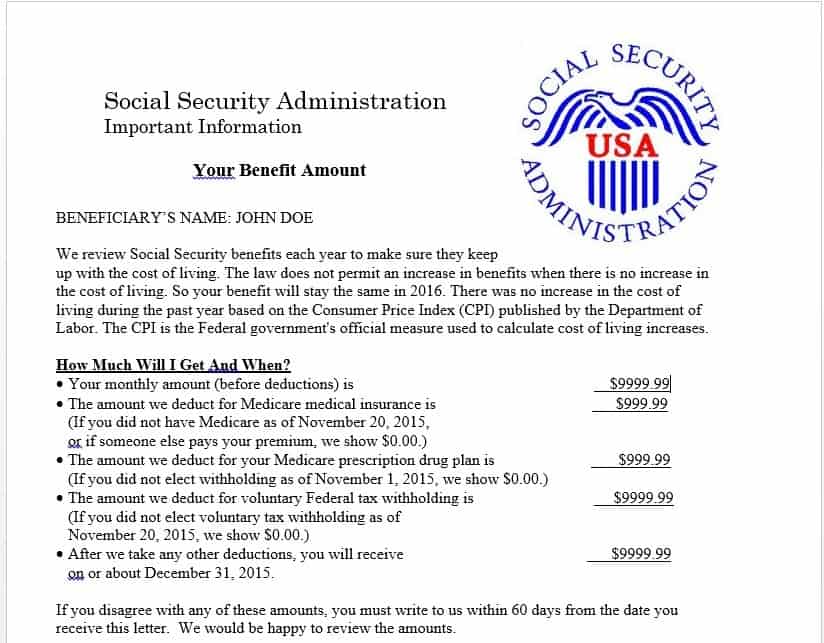It?s Definitely Not the Kind of Greeting Card Beneficiaries Want This Holiday Season

Each year the Social Security Administration reviews beneficiaries’ benefits and sends out millions of notices to ensure you know what to expect in next year’s Social Security check. Unfortunately, as was announced last month, there will be NO cost of living increase in 2016.
“We review Social Security benefits each year to make sure they keep up with the cost of living. The law does not permit an increase in benefits when there is no increase in the cost of living. So your benefit will stay the same in 2016. There was no increase in the cost of living during the past year based on the Consumer Price Index (CPI) published by the Department of Labor. The CPI is the Federal government’s official measure used to calculate cost of living increases.”…Social Security Administration 2016 Benefit mailing
Since 2009, Social Security beneficiaries have seen a 0% COLA increase three times (2009, 2010, 2016) with an average of just 1.2% increase over those years, confirming yet again, that the current Social Security COLA formula isn’t accurately measuring seniors’ expenses. Seniors across this nation understand how important having an accurate measure of the increase in their real costs is to their day-to-day survival. While there has been a lot of talk in Washington about the need to find a more accurate COLA formula; unfortunately, that attention has largely focused on ways to cut the COLA even further. Leaving many Americans to wonder what’s less than zero? If accurate inflation protection for seniors is truly our goal, Congress needs to adopt a fully developed CPI for the elderly (CPI-E).
Research has shown that spending patterns differ between the elderly and the general population, especially on health care. Seniors 65 and older spend more than twice as much on health care, and those 75 and older spend nearly three times more than younger consumers. Not only do health care expenditures steadily increase with age but health care costs consistently rise much faster than general inflation. The current price index (CPI-W) does not take these critical differences in the elderly population into consideration. The chained CPI doubles-down on that flaw. Even worse, the proposed chained CPI will cut COLAs immediately for current and future retirees, veterans, the poor and people with disabilities.
GOP Presidential candidates Republican Congressional leaders continue to support adoption of the so-called “Chained” CPI because they claim the current COLA formula is too generous and should be reduced. Reduced?!?
Senator Elizabeth Warren has proposed legislation to address the immediate need by providing a $580 Social Security boost. NCPSSM supports Warren’s efforts and will continue to fight for a fully developed cost of living formula geared to America’s elderly.
High RX Drug Prices Certainly Not News to Seniors



The federal Health and Human Services Department has signaled they’re looking for a way to curb rising prescription drug prices. They need to do so because rising drug costs have now overtaken a long stretch of stable premiums. In other words, while Medicare has successfully controlled premiums those successes are lost when seniors in Part D continue to face growing prescription costs.
“Andy Slavitt, acting administrator for the Centers for Medicare and Medicaid Services, said his agency spent $140 billion on prescription drugs and that spending on medicines increased 13 percent in 2014 while overall health spending grew 5 percent.” ….HHS Airs Concerns About Rising Drug Prices, Congressional Quarterly
“Spending on medicines increased 13 percent in 2014, compared to 5 percent for health care overall, Slavitt said. It was the highest rate of drug spending growth since 2001.”…Obama administration sets stage for a debate on drug costs, Associated Press
One simple solution is to allow Medicare to negotiate prices for prescription drugs which could save the program and its beneficiaries billions of dollars.
“The law that established Medicare Part D explicitly prohibits the prescription drug program from negotiating lower drug costs for beneficiaries. The major pharmaceutical companies adamantly defend this rule, contending that the higher prices are necessary to support the industry’s investment in research and development. However, a comparison of the prices paid by Part D with those paid by the Department of Veterans Affairs (VA) and other agencies shows that Part D could save billions of dollars through the use of additional negotiation techniques. Our analysis finds that the VA attains drug prices that, on average, are 48 percent lower than Part D plan prices for the top 10 drugs covered by the program.” …”Price Negotiation for the Medicare Drug Program: It is Time to Lower Costs for Seniors,” NCPSSM Issue Brief
It’s time to hold America’s drug makers accountable.
“Heather Block, a breast cancer patient from Lewes, Delaware, told the forum that her costs have been so high she could face bankruptcy if she beats the odds against her advanced disease. ‘Innovation is meaningless if nobody can afford it,’ she said”… Associated Press
Will Congress Put Budget $s to Work for Average Americans?
Passing a budget in Washington these days is uglier than making sausage. The next step (now underway), when Congressional appropriators actually decide where to spend those budgeted dollars, may be even worse.
As a reminder, the 2016 budget deal passed last month was far from perfect; however, it did:
· Prevent a 19% cut in Social Security Disability Insurance benefits that would have occurred in late 2016
· Mitigate a 52% Medicare Part B premium increase for 30% of Medicare beneficiaries
· Alleviate an increase in the Part B deductible for all beneficiaries, lowering it from a projected $223 to $167
The budget deal also provided for a roughly $33 billion increase in domestic programs. Many, like Older Americans Act programs, have been


However, Congressional conservatives have very different ideas than Democrats of where those extra budget dollars should go. In a classic “guns vs. butter” battle, GOP appropriators propose less for domestic programs, like the Older Americans Act, and $8 billion more for the nondefense war account beyond the increase already requested by the President. According to Congressional Quarterly:
“Connecticut Democrat Rosa DeLauro, ranking member of the House Labor-HHS-Education Appropriations Subcommittee, on Tuesday slammed the new, post-budget-deal allocation for the spending bill she helps oversee, which typically accounts for roughly one-third of all nondefense discretionary spending.
DeLauro said the revised discretionary allocation for Labor-HHS-Education is $5.2 billion above the fiscal 2015 enacted level (PL 113-235) of $156.76 billion, or roughly $161.69 billion. She said the bill should receive an increase of closer to $10 billion above the enacted level. The budget accord provided a roughly $33 billion increase to domestic programs above the sequester level, when a roughly $8 billion increase to the nondefense war account beyond the president’s request is included.
“I’m opposed to the allocation. The recent allocation is well below the percentage that Labor-H should have, given that Labor-H is 32 percent of the nondefense discretionary dollars,” DeLauro said.”
The Older Americans Act is the backbone of the nation’s home and community supports system, helping older adults age with independence and dignity by providing them with much-needed in-home support, meals, transportation, caregiver assistance and ombudsman programs to help protect residents in nursing homes.
The Leadership Council of Aging Organizations, chaired by NCPSSM, is mobilizing Americans to call their members of Congress and ask them to do more, not less, for the growing number of older Americans by protecting aging services and increasing funding for the Older Americans Act and Elder Justice programs. Our seniors are counting on them.
USE OUR LEGISLATIVE HOTLINE
AND MAKE YOUR CALL TO CONGRESS
(800) 998-0180
2016 Determines the Future of Social Security & Medicare
There is a lot at stake in the 2016 election because the differences between candidates’ plans for ?#SocialSecurity?, ?#Medicare? and Medicaid are stark. Seniors’ votes will make a difference so please help us advocate, educate and keep the candidates accountable for their positions on America’s most successful programs!
$580 Social Security Boost for Seniors



Senator Elizabeth Warren (D-MA) has introduced legislation, cosponsored by a host of Democratic Senators and supported by us here at the National Committee, to send every senior citizen and disabled veteran in America a check for $580. The “SAVE Benefits Act” follows the announcement last month that beneficiaries would not receive any COLA increase next year.
Senator Warren describes her legislation this way:
“Although the cost of core goods and services is projected to rise next year, millions of Americans will see no increase in the benefits they rely on to make ends meet. Meanwhile, CEO compensation for the top 350 firms increased by 3.9 percent last year. The Seniors and Veterans Emergency Benefits Act (SAVE Benefits Act) would give about 70 million seniors, veterans, people with disabilities, and others an emergency payment equal to 3.9 percent of the average annual Social Security benefit, about $581 – the same percentage raise as the top CEOs.
A $581 increase could cover almost three months of groceries for seniors or a year’s worth of out-of-pocket costs on critical prescription drugs for the average Medicare beneficiary. The bill would lift more than 1 million Americans out of poverty. The cost of this emergency payment would be covered by closing a tax loophole allowing corporations to write off executive bonuses as a business expense for “performance pay.” The substantial additional revenue saved by closing the CEO compensation loophole would be used to bolster and extend the life of the Social Security and Disability trust funds.”
For seniors who continue to see their costs increase, particularly their healthcare, news that there would be no COLA increase in 2016 makes no sense. It highlights the need to adopt a more accurate measure of seniors’ true expenses through the adoption of a CPI for the elderly (CPI-E).
“The current Social Security COLA formula isn’t accurately measuring seniors’ expenses. Seniors across this nation understand how important having an accurate measure of the increase in their real costs is to their day-to-day survival. While there has been a lot of talk in Washington about the need to find a more accurate COLA formula; unfortunately, that attention has largely focused on ways to cut the COLA even further. Leaving many Americans to wonder what’s less than zero? If accurate inflation protection for seniors is truly our goal, Congress needs to adopt a fully developed CPI for the elderly (CPI-E). Until then, we urge Congress to act quickly to mitigate the devastating Medicare hikes headed for millions of Americans who can’t afford them.” …Max Richtman, NCPSSM President/CEO
Senator Warren talked about why seniors need this legislation on “All In” with Chris Hayes.
It?s Definitely Not the Kind of Greeting Card Beneficiaries Want This Holiday Season



Each year the Social Security Administration reviews beneficiaries’ benefits and sends out millions of notices to ensure you know what to expect in next year’s Social Security check. Unfortunately, as was announced last month, there will be NO cost of living increase in 2016.
“We review Social Security benefits each year to make sure they keep up with the cost of living. The law does not permit an increase in benefits when there is no increase in the cost of living. So your benefit will stay the same in 2016. There was no increase in the cost of living during the past year based on the Consumer Price Index (CPI) published by the Department of Labor. The CPI is the Federal government’s official measure used to calculate cost of living increases.”…Social Security Administration 2016 Benefit mailing
Since 2009, Social Security beneficiaries have seen a 0% COLA increase three times (2009, 2010, 2016) with an average of just 1.2% increase over those years, confirming yet again, that the current Social Security COLA formula isn’t accurately measuring seniors’ expenses. Seniors across this nation understand how important having an accurate measure of the increase in their real costs is to their day-to-day survival. While there has been a lot of talk in Washington about the need to find a more accurate COLA formula; unfortunately, that attention has largely focused on ways to cut the COLA even further. Leaving many Americans to wonder what’s less than zero? If accurate inflation protection for seniors is truly our goal, Congress needs to adopt a fully developed CPI for the elderly (CPI-E).
Research has shown that spending patterns differ between the elderly and the general population, especially on health care. Seniors 65 and older spend more than twice as much on health care, and those 75 and older spend nearly three times more than younger consumers. Not only do health care expenditures steadily increase with age but health care costs consistently rise much faster than general inflation. The current price index (CPI-W) does not take these critical differences in the elderly population into consideration. The chained CPI doubles-down on that flaw. Even worse, the proposed chained CPI will cut COLAs immediately for current and future retirees, veterans, the poor and people with disabilities.
GOP Presidential candidates Republican Congressional leaders continue to support adoption of the so-called “Chained” CPI because they claim the current COLA formula is too generous and should be reduced. Reduced?!?
Senator Elizabeth Warren has proposed legislation to address the immediate need by providing a $580 Social Security boost. NCPSSM supports Warren’s efforts and will continue to fight for a fully developed cost of living formula geared to America’s elderly.
High RX Drug Prices Certainly Not News to Seniors



The federal Health and Human Services Department has signaled they’re looking for a way to curb rising prescription drug prices. They need to do so because rising drug costs have now overtaken a long stretch of stable premiums. In other words, while Medicare has successfully controlled premiums those successes are lost when seniors in Part D continue to face growing prescription costs.
“Andy Slavitt, acting administrator for the Centers for Medicare and Medicaid Services, said his agency spent $140 billion on prescription drugs and that spending on medicines increased 13 percent in 2014 while overall health spending grew 5 percent.” ….HHS Airs Concerns About Rising Drug Prices, Congressional Quarterly
“Spending on medicines increased 13 percent in 2014, compared to 5 percent for health care overall, Slavitt said. It was the highest rate of drug spending growth since 2001.”…Obama administration sets stage for a debate on drug costs, Associated Press
One simple solution is to allow Medicare to negotiate prices for prescription drugs which could save the program and its beneficiaries billions of dollars.
“The law that established Medicare Part D explicitly prohibits the prescription drug program from negotiating lower drug costs for beneficiaries. The major pharmaceutical companies adamantly defend this rule, contending that the higher prices are necessary to support the industry’s investment in research and development. However, a comparison of the prices paid by Part D with those paid by the Department of Veterans Affairs (VA) and other agencies shows that Part D could save billions of dollars through the use of additional negotiation techniques. Our analysis finds that the VA attains drug prices that, on average, are 48 percent lower than Part D plan prices for the top 10 drugs covered by the program.” …”Price Negotiation for the Medicare Drug Program: It is Time to Lower Costs for Seniors,” NCPSSM Issue Brief
It’s time to hold America’s drug makers accountable.
“Heather Block, a breast cancer patient from Lewes, Delaware, told the forum that her costs have been so high she could face bankruptcy if she beats the odds against her advanced disease. ‘Innovation is meaningless if nobody can afford it,’ she said”… Associated Press
Will Congress Put Budget $s to Work for Average Americans?
Passing a budget in Washington these days is uglier than making sausage. The next step (now underway), when Congressional appropriators actually decide where to spend those budgeted dollars, may be even worse.
As a reminder, the 2016 budget deal passed last month was far from perfect; however, it did:
· Prevent a 19% cut in Social Security Disability Insurance benefits that would have occurred in late 2016
· Mitigate a 52% Medicare Part B premium increase for 30% of Medicare beneficiaries
· Alleviate an increase in the Part B deductible for all beneficiaries, lowering it from a projected $223 to $167
The budget deal also provided for a roughly $33 billion increase in domestic programs. Many, like Older Americans Act programs, have been


However, Congressional conservatives have very different ideas than Democrats of where those extra budget dollars should go. In a classic “guns vs. butter” battle, GOP appropriators propose less for domestic programs, like the Older Americans Act, and $8 billion more for the nondefense war account beyond the increase already requested by the President. According to Congressional Quarterly:
“Connecticut Democrat Rosa DeLauro, ranking member of the House Labor-HHS-Education Appropriations Subcommittee, on Tuesday slammed the new, post-budget-deal allocation for the spending bill she helps oversee, which typically accounts for roughly one-third of all nondefense discretionary spending.
DeLauro said the revised discretionary allocation for Labor-HHS-Education is $5.2 billion above the fiscal 2015 enacted level (PL 113-235) of $156.76 billion, or roughly $161.69 billion. She said the bill should receive an increase of closer to $10 billion above the enacted level. The budget accord provided a roughly $33 billion increase to domestic programs above the sequester level, when a roughly $8 billion increase to the nondefense war account beyond the president’s request is included.
“I’m opposed to the allocation. The recent allocation is well below the percentage that Labor-H should have, given that Labor-H is 32 percent of the nondefense discretionary dollars,” DeLauro said.”
The Older Americans Act is the backbone of the nation’s home and community supports system, helping older adults age with independence and dignity by providing them with much-needed in-home support, meals, transportation, caregiver assistance and ombudsman programs to help protect residents in nursing homes.
The Leadership Council of Aging Organizations, chaired by NCPSSM, is mobilizing Americans to call their members of Congress and ask them to do more, not less, for the growing number of older Americans by protecting aging services and increasing funding for the Older Americans Act and Elder Justice programs. Our seniors are counting on them.
USE OUR LEGISLATIVE HOTLINE
AND MAKE YOUR CALL TO CONGRESS
(800) 998-0180
2016 Determines the Future of Social Security & Medicare
There is a lot at stake in the 2016 election because the differences between candidates’ plans for ?#SocialSecurity?, ?#Medicare? and Medicaid are stark. Seniors’ votes will make a difference so please help us advocate, educate and keep the candidates accountable for their positions on America’s most successful programs!
$580 Social Security Boost for Seniors



Senator Elizabeth Warren (D-MA) has introduced legislation, cosponsored by a host of Democratic Senators and supported by us here at the National Committee, to send every senior citizen and disabled veteran in America a check for $580. The “SAVE Benefits Act” follows the announcement last month that beneficiaries would not receive any COLA increase next year.
Senator Warren describes her legislation this way:
“Although the cost of core goods and services is projected to rise next year, millions of Americans will see no increase in the benefits they rely on to make ends meet. Meanwhile, CEO compensation for the top 350 firms increased by 3.9 percent last year. The Seniors and Veterans Emergency Benefits Act (SAVE Benefits Act) would give about 70 million seniors, veterans, people with disabilities, and others an emergency payment equal to 3.9 percent of the average annual Social Security benefit, about $581 – the same percentage raise as the top CEOs.
A $581 increase could cover almost three months of groceries for seniors or a year’s worth of out-of-pocket costs on critical prescription drugs for the average Medicare beneficiary. The bill would lift more than 1 million Americans out of poverty. The cost of this emergency payment would be covered by closing a tax loophole allowing corporations to write off executive bonuses as a business expense for “performance pay.” The substantial additional revenue saved by closing the CEO compensation loophole would be used to bolster and extend the life of the Social Security and Disability trust funds.”
For seniors who continue to see their costs increase, particularly their healthcare, news that there would be no COLA increase in 2016 makes no sense. It highlights the need to adopt a more accurate measure of seniors’ true expenses through the adoption of a CPI for the elderly (CPI-E).
“The current Social Security COLA formula isn’t accurately measuring seniors’ expenses. Seniors across this nation understand how important having an accurate measure of the increase in their real costs is to their day-to-day survival. While there has been a lot of talk in Washington about the need to find a more accurate COLA formula; unfortunately, that attention has largely focused on ways to cut the COLA even further. Leaving many Americans to wonder what’s less than zero? If accurate inflation protection for seniors is truly our goal, Congress needs to adopt a fully developed CPI for the elderly (CPI-E). Until then, we urge Congress to act quickly to mitigate the devastating Medicare hikes headed for millions of Americans who can’t afford them.” …Max Richtman, NCPSSM President/CEO
Senator Warren talked about why seniors need this legislation on “All In” with Chris Hayes.



